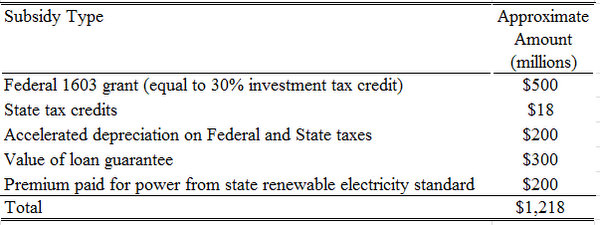At the blog Marginal Revolution, economist Alex Tabarrok digs into a memo by high ranking officials inside the Obama administration on the green energy loan guarantee program (the same type of program which loaned a half billion dollars to the now-bankrupt Solyndra). Amazingly, the memo highlights numerous flaws with the very loan guarantee program the administration continues to champion.
Just how flawed is the green energy loan guarantee program, you ask? According to the memo’s authors, one wind project in particular will receive $1.2 billion in government subsidies for a $1.9 billion project, making it about 65 percent subsidized. And, the authors omit that the project will only create 400 construction jobs and 35 permanent jobs. In other words, each one of these 35 permanent jobs cost over $30 million each.
The memo, written by Larry Summers, Ron Klain, Carol Browner. At the time, Summers was the Chairman of the National Economic Council, Klain was Vice President Biden’s Chief of Staff, and Browner was the White House Energy and Climate Change Advisor. In the memo, these high ranking officials explain three problems with the loan guarantee program. As Tabarrok explains:
The memo says that OMB and Treasury were concerned about three problems, “double dipping” (massive government subsidies from multiple sources), lack of “skin in the game” from private investors and ”non-incremental investment,” the funding of projects which would occur even without the loan guarantee.
How much double dipping are we talking about? Summers, Klain, and Browner describe the Shepherds Flat wind project and note, according to them, that total government subsidies for the project are over $1.2 billion. This dwarfs the $100 million investment in the project Google was happy to tout. Here’s the Summers, Klain, and Browner explanation of the Shepherds Flat project:
The Shepherds Flat loan guarantee illustrates some of the economic and public policy issues raised by OMB and Treasury. Shepherds Flat is an 845-megawatt wind farm proposed for Oregon. This $1.9 billion project would consist of 338 GE wind turbines manufactured in South Carolina and Florida and, upon completion; it would represent the largest wind farm in the country.
The sponsor’s equity is about 11% of the project costs, and would generate an estimated return on equity of 30%.
Double dipping: The total government subsidies are about $1.2 billion.
Skin in the game: The government would provide a significant subsidy (65+%), while the sponsor would provide little skin in the game (equity about 10%).
Non-incremental investment: This project would likely move without the loan guarantee. The economics are favorable for wind investment given tax credits and state renewable energy standards. GE signaled through Hill staff that it considered going to the private market for financing out of frustration with the review process. The return on equity is high (30%) because of tax credits, grants, and selling power at above-market rates, which suggests that the alternative of private financing would not make the project financially non-viable.
Carbon reduction benefits: If this wind power displaced power generated from sources with the average California carbon intensity, it would result in about 18 million fewer tons of CO2 emissions through 2033. Carbon reductions would have to be valued at nearly $130 per ton CO2 for the climate benefits to equal the subsidies (more than 6 times the primary estimate used by the government in evaluating rules).
This is a serious indictment in and of itself, and reading this, one questions how the administration could in good conscience proceed in approving the project. No matter how you slice it, $1.2 billion in subsidies is a lot. As Tabarrok explains:
In my view, the Summers/Klain/Browner analysis was a damning indictment of the Shepherds Flat project. The taxpayers were expected to fund by far the largest share of the bills and also of the risk and in return they weren’t getting many benefits in terms of reduced pollution. In contrast, Caithness Energy and GE Energy Financial Services, the corporations behind the project, weren’t taking much risk but they stood to profit handsomely. I guess that is why they call it “green” energy.
In short, the Shepherds Flat project was corporate welfare masquerading under an environmental rainbow. [emphasis added]
Despite understanding that a loan guarantee for the Shepherds Flat project was completely unnecessary, the administration provided the loan guarantee anyway. No real surprise since the wind turbines come from GE, one of the administration’s favorite companies.
So what does $1.2 billion in government subsidies provide in terms of job creation? According to CNN Money, 400 construction jobs and 35 permanent jobs. In other words, each one of these full time jobs cost over $30 million each. That is a raw deal for Americans.
Tabarrok rightly concludes, “the real scandal is not what happens when everything goes wrong [such as Solyndra] but how these programs work when everything goes right.”




